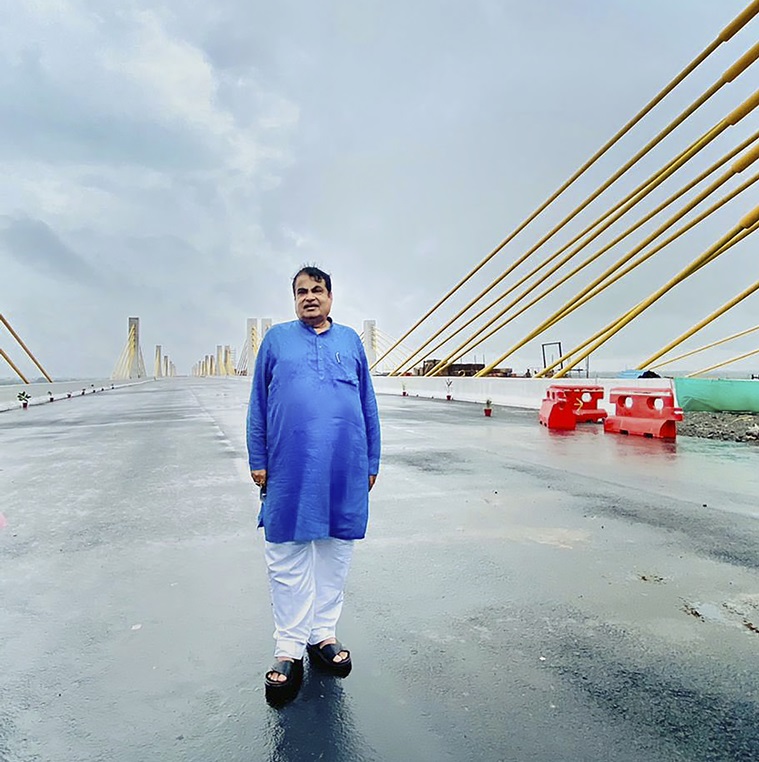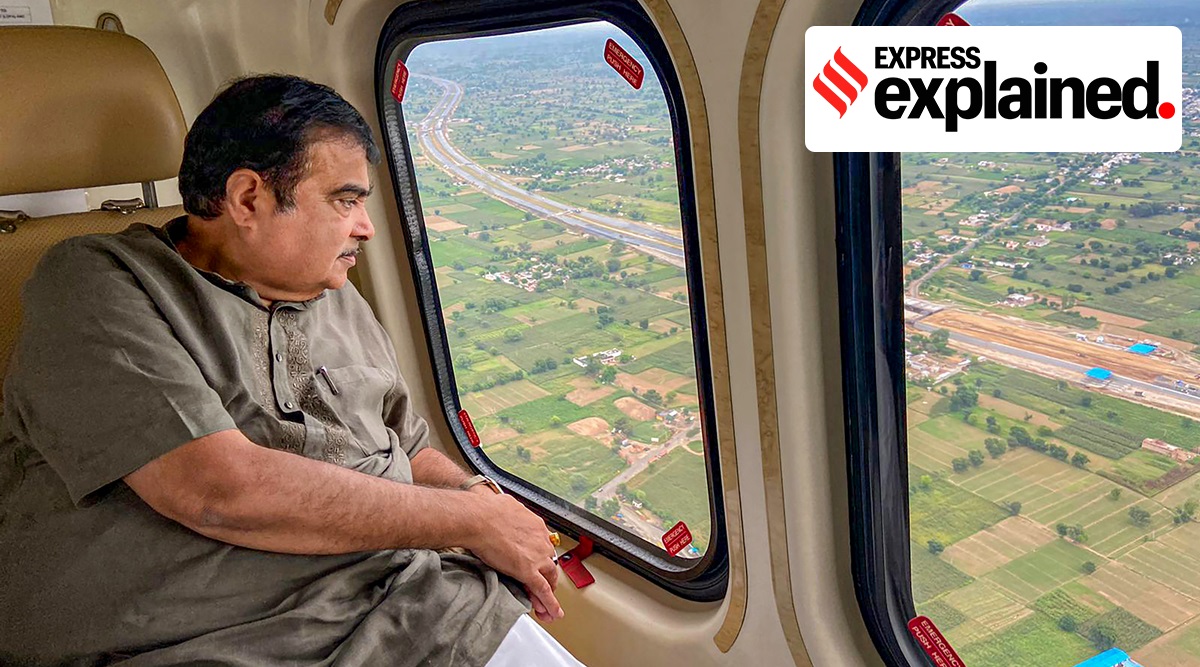World’s longest expressway between Delhi and Mumbai to open in March 2023: All you need to know
Delhi-Mumbai Expressway: The 1380-km eight-lane expressway — passing through Delhi, Haryana, Rajasthan, Madhya Pradesh and Gujarat — will reduce travel time between the cities to 12 hours.
By:
Explained Desk | New Delhi |
September 18, 2021 12:38:47 pm
Union Minister for Road Transport and Highways Nitin Gadkari during inspection of Delhi-Mumbai Expressway in the Dausa, Rajasthan region. (PTI Photo)
Union Minister for Road Transport and Highways Nitin Gadkari on Friday concluded the two-day review of the work progress on the 1380-km
eight-lane Delhi-Mumbai Expressway, which will reduce travel time between certain cities to 12-12.5 hours from 24 hours.
Gadkari toured Delhi, Haryana, Rajasthan, Madhya Pradesh and Gujarat over the two days to review progress of the project, being built at a cost of Rs 98,000 crore and scheduled to be completed by March 2023.
What is the Delhi-Mumbai expressway?
- Cost: Rs 98,000 crore
- Length: 1,380 km
- Completion schedule: The first phase from Delhi-Jaipur (Dausa)-Lalsot and Vadodara-Ankleshwar is expected to be open to traffic by March 2022. The expressway is expected to be completed by March 2023.
- The project was kickstarted in 2018 with the foundation stone being laid on March 9, 2019.
- The expressway will feature a spur to Jewar Airport and Jawaharlal Nehru Port to Mumbai through a spur in Mumbai.
- The expressway will improve connectivity to economic hubs like Jaipur, Kishangarh, Ajmer, Kota, Chittorgarh, Udaipur, Bhopal, Ujjain, Indore, Ahmedabad, Vadodara and Surat.
- Out of the 1,380 km, contracts have been awarded for more than 1,200 km where work is under progress.
- Over 15,000 hectares of land has been acquired across states for the construction of the Delhi-Mumbai expressway.
Key features of Delhi-Mumbai Expressway
- The eight-lane access-controlled expressway can be expanded to a 12-lane expressway depending on the volume of traffic.
- The expressway will have wayside amenities – resorts, restaurants, food courts, fuel stations, facilities for truckers, logistics parks.
- A helicopter ambulance service for accident victims and a heliport, which will use drone services for business as well.
- Over two million trees and shrubs are planned to be planted along the highway.
- The expressway is the first in Asia and only the second in the world to feature animal overpasses to facilitate unrestricted movement of wildlife.
- The expressway will also include two iconic 8-lane tunnels, one tunneling through Mukundra sanctuary without disturbing the endangered fauna in the region for 4 km and the second 4 km eight-lane tunnel will pass through the Matheran eco-sensitive zone.
- The expressway will result in annual fuel savings of more than 320 million litres and reduce CO2 emissions by 850 million kg which is equivalent to the planting of 40 million trees.
- More than 12 lakh tonnes of steel will be consumed in the construction of the expressway, which is equivalent to building 50 Howrah bridges.
- 80 lakh tonnes of cement will be consumed for the project, which is approximately 2% of India’s annual cement production capacity.
- The project has also created employment for thousands of trained civil engineers and more than 50 lakh man days of work.



Nitin Gadkari during the inspection of a bridge built across the Narmada river near Bharuch, Friday, Sept. 17, 2021. (PTI Photo)
Haryana
More than 160 km stretch of the expressway which passes through Haryana is being built at a cost of Rs 10,400 crore. “This corridor will improve connectivity in Nuh and Palwal through multiple interchanges to connect the expressway with major highways like KMP and DND Sohna. To address the serious problem of air pollution and traffic congestion in Delhi-NCR, the ministry is undertaking 15 projects worth Rs 53,000 crore, of which 14 projects have been initiated. This expressway will lead to a reduction of 27 per cent in vehicular pollution in Delhi,” Gadkari said.
At least 73 villages in this region will benefit from this stretch.
Rajasthan
Of the total expressway, 374 km passes through the state of Rajasthan and the section is being built at a total capital cost of more than 16,600 crores, with contracts for all 374 kms already awarded.
The corridor will pass through the districts of Alwar, Bharatpur, Dausa, Sawai Madhopur, Tonk, Bundi and Kota. Multiple bridges are being built across the rivers of the state like Banganga river, Banas river, Mezriver and Chambal river. An 1,100-m long elevated stretch has been planned across the Chakan Dam which will be an engineering marvel.
All the packages in Rajathan are under progress with the Delhi-Jaipur (Dausa)-Lalsot section of 214 km targeted to be completed and open to traffic by March 2022. The remaining section from Lalsot to Kota is targeted to be completed by March 2023.
Madhya Pradesh
The Delhi-Mumbai Expressway will pass through Madhya Pradesh (nearly 250km) and is being constructed at an estimated cost of Rs 8,500 crore. Gadkari reviewed the progress in construction of the expressway in Ratlam on Thursday.
According to officials, the eight-lane Delhi-Vadodara-Mumbai Expressway would pass through western MP covering 102.4 km area stretch in Mandsaur, 90.1 km in Ratlam and 52 km in Jhabual. They said of the around 245 km of this road project in Madhya Pradesh, 106 km had been constructed and the time limit to complete the Expressway was November 2022.
Gujarat
As a part of the expressway project, 60 major bridges, 17 interchanges, 17 flyovers and eight road over bridges (ROBs) will be built in Gujarat, Gadkari said while reviewing work progress in Bharuch. The minister said 33 wayside amenities are also proposed to be build on this expressway to provide world-class transport facilities as well as generate employment opportunities in the state.
Farmers fairly compensated
Gadkari said the ministry, in a liberal approach, had paid 1.5 times more than the market price to farmers for land acquisition. “I appeal to farmers to not sell their land to builders and developers, who usually profit when prices increase after road construction. They (farmers) will get more money if they develop the land,” he said.









